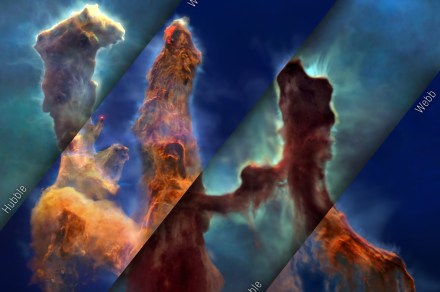 This image is a mosaic of visible-light and infrared-light views of the same frame from the Pillars of Creation visualization. The three-dimensional model of the pillars created for the visualization sequence is alternately shown in the Hubble Space Telescope version (visible light) and the Webb Space Telescope version (infrared light). Greg Bacon (STScI), Ralf Crawford (STScI), Joseph DePasquale (STScI), Leah Hustak (STScI), Christian Nieves (STScI), Joseph Olmsted (STScI), Alyssa Pagan (STScI), Frank Summers (STScI), NASA’s Universe of Learning
This image is a mosaic of visible-light and infrared-light views of the same frame from the Pillars of Creation visualization. The three-dimensional model of the pillars created for the visualization sequence is alternately shown in the Hubble Space Telescope version (visible light) and the Webb Space Telescope version (infrared light). Greg Bacon (STScI), Ralf Crawford (STScI), Joseph DePasquale (STScI), Leah Hustak (STScI), Christian Nieves (STScI), Joseph Olmsted (STScI), Alyssa Pagan (STScI), Frank Summers (STScI), NASA’s Universe of Learning
The Pillars of Creation are perhaps the most famous object in all of astronomy. Part of the Eagle Nebula, this vista was first captured by the Hubble Space Telescope in 1995, and has captivated the public ever since with its dramatic rising pillars of dust and gas that stretch several light-years high. The nebula has been imaged often since then, including again by Hubble in 2014 and more recently by the James Webb Space Telescope in 2022.
Now, scientists working with the Hubble and Webb telescopes have released a striking visualization, comparing the different views of the pillars taken by the two different space telescopes. If you’re wondering why scientists would bother taking many images of the same object with different telescopes, it’s sometimes because technology and processing has improved so much that it offers a better view (as was the case with the 1995 and 2014 Hubble images), and sometimes because different telescopes operate in different wavelengths of light so they can get different views of the object (as is the case with the Hubble and Webb images).

“When we combine observations from NASA’s space telescopes across different wavelengths of light, we broaden our understanding of the universe,” said Mark Clampin, Astrophysics Division director at NASA, in a statement. “The Pillars of Creation region continues to offer us new insights that hone our understanding of how stars form. Now, with this new visualization, everyone can experience this rich, captivating landscape in a new way.”

As well as comparing the images, the team from NASA has also created a 3D visualization of the pillars, showing what they look like from different angles.
“By flying past and amongst the pillars, viewers experience their three-dimensional structure and see how they look different in the Hubble visible-light view versus the Webb infrared-light view,” explained principal visualization scientist Frank Summers of the Space Telescope Science Institute (STScI) in Baltimore, who led the movie development team for NASA’s Universe of Learning. “The contrast helps them understand why we have more than one space telescope to observe different aspects of the same object.”
“The Pillars of Creation were always on our minds to create in 3D. Webb data in combination with Hubble data allowed us to see the Pillars in more complete detail,” said production lead Greg Bacon of STScI. “Understanding the science and how to best represent it allowed our small, talented team to meet the challenge of visualizing this iconic structure.”
NASA has even created a 3D printable model of the pillars for those who want to make their own model at home.
Editors’ Recommendations
Gorgeous Webb image of Serpens Nebula shows a strange alignment
James Webb discovers the most distant galaxy ever observed
James Webb observes extremely hot exoplanet with 5,000 mph winds
See incredible time lapses of two of space’s most famous objects
James Webb images capture the galactic winds of newborn stars
>>> Read full article>>>
Copyright for syndicated content belongs to the linked Source : Digital Trends – https://www.digitaltrends.com/space/pillars-of-creation-3d-visualization/































